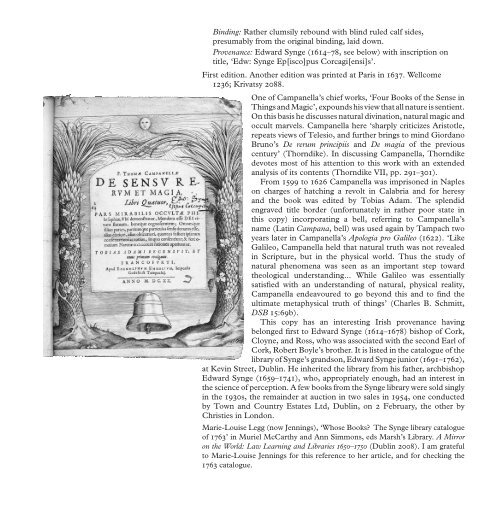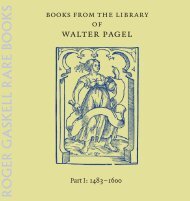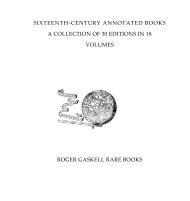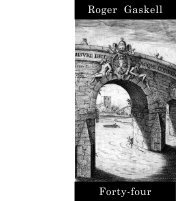pdf - Roger Gaskell Rare Books
pdf - Roger Gaskell Rare Books
pdf - Roger Gaskell Rare Books
You also want an ePaper? Increase the reach of your titles
YUMPU automatically turns print PDFs into web optimized ePapers that Google loves.
Binding: Rather clumsily rebound with blind ruled calf sides,<br />
presumably from the original binding, laid down.<br />
Provenance: Edward Synge (1614–78, see below) with inscription on<br />
title, ‘Edw: Synge Ep[isco]pus Corcagi[ensi]s’.<br />
First edition. Another edition was printed at Paris in 1637. Wellcome<br />
1236; Krivatsy 2088.<br />
One of Campanella’s chief works, ‘Four <strong>Books</strong> of the Sense in<br />
Things and Magic’, expounds his view that all nature is sentient.<br />
On this basis he discusses natural divination, natural magic and<br />
occult marvels. Campanella here ‘sharply criticizes Aristotle,<br />
repeats views of Telesio, and further brings to mind Giordano<br />
Bruno’s De rerum principiis and De magia of the previous<br />
century’ (Thorndike). In discussing Campanella, Thorndike<br />
devotes most of his attention to this work with an extended<br />
analysis of its contents (Thorndike VII, pp. 291–301).<br />
From 1599 to 1626 Campanella was imprisoned in Naples<br />
on charges of hatching a revolt in Calabria and for heresy<br />
and the book was edited by Tobias Adam. The splendid<br />
engraved title border (unfortunately in rather poor state in<br />
this copy) incorporating a bell, referring to Campanella’s<br />
name (Latin Campana, bell) was used again by Tampach two<br />
years later in Campanella’s Apologia pro Galileo (1622). ‘Like<br />
Galileo, Campanella held that natural truth was not revealed<br />
in Scripture, but in the physical world. Thus the study of<br />
natural phenomena was seen as an important step toward<br />
theological understanding... While Galileo was essentially<br />
satisWed with an understanding of natural, physical reality,<br />
Campanella endeavoured to go beyond this and to Wnd the<br />
ultimate metaphysical truth of things’ (Charles B. Schmitt,<br />
DSB 15:69b).<br />
This copy has an interesting Irish provenance having<br />
belonged first to Edward Synge (1614–1678) bishop of Cork,<br />
Cloyne, and Ross, who was associated with the second Earl of<br />
Cork, Robert Boyle’s brother. It is listed in the catalogue of the<br />
library of Synge’s grandson, Edward Synge junior (1691–1762),<br />
at Kevin Street, Dublin. He inherited the library from his father, archbishop<br />
Edward Synge (1659–1741), who, appropriately enough, had an interest in<br />
the science of perception. A few books from the Synge library were sold singly<br />
in the 1930s, the remainder at auction in two sales in 1954, one conducted<br />
by Town and Country Estates Ltd, Dublin, on 2 February, the other by<br />
Christies in London.<br />
MarieLouise Legg (now Jennings), ‘Whose <strong>Books</strong>? The Synge library catalogue<br />
of 1763’ in Muriel McCarthy and Ann Simmons, eds Marsh’s Library. A Mirror<br />
on the World: Law Learning and Libraries 1650–1750 (Dublin 2008). I am grateful<br />
to MarieLouise Jennings for this reference to her article, and for checking the<br />
1763 catalogue.







